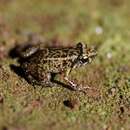Eleutherodactylus é um gênero de anfíbios da família Eleutherodactylidae. Está distribuído do sul dos Estados Unidos (sul do Texas) e oeste do México ao sul até Belize e Guatemala; e nas Antilhas das Bahamas e Cuba ao leste e sul até as ilhas de sotavento no Caribe.[1]
Nomenclatura e taxonomia
Hedges, em 1989, através de uma análise molecular dividiu o gênero Eleutherodactylus em cinco subgêneros: Craugastor, Eleutherodactylus, Pelorius, Syrrhophus e Euhyas.[2] Darst e Canatella, em 2004, demonstraram que o gênero era polifilético através de análise filogenética molecular.[3] Em 2005, o subgênero Craugastor foi elevado a categoria de gênero distinto.[4] Em 2007, Pristimantis foi removido da sinonímia de Eleutherodactylus e elevado a gênero distinto.[5] Em 2008, o gênero foi revisado e proposto cinco subgêneros: Eleutherodactylus, Euhyas, Pelorius, Schwartzius e Syrrhopus.[6] Em 2011, uma análise filogenética confirmou a monofilia do gênero, e também que os subgêneros Eleutherodactylus, Schwartzius e Syrrhopus são monofiléticos, enquanto o Euhyas é polifilético.[7]
Espécies
As seguintes espécies são reconhecidas no gênero Eleutherodactylus:[1]
-
Eleutherodactylus aporostegus Schwartz, 1965
-
Eleutherodactylus bothroboans Schwartz, 1965
-
Eleutherodactylus campi (Stejneger, 1915)
-
Eleutherodactylus counouspeus Schwartz, 1964
-
Eleutherodactylus diplasius Schwartz, 1973
-
Eleutherodactylus erythroproctus Schwartz, 1960
-
Eleutherodactylus feichtingeri Díaz, Hedges & Schmid, 2012
-
Eleutherodactylus limbensis Lynn, 1958
-
Eleutherodactylus melatrigonum Schwartz, 1966
-
Eleutherodactylus notidodes Schwartz, 1966
-
Eleutherodactylus olibrus Schwartz, 1958
-
Eleutherodactylus orarius (Dixon, 1957)
-
Eleutherodactylus paralius Schwartz, 1976
-
Eleutherodactylus rucillensis Cochran, 1939
-
Eleutherodactylus sommeri Schwartz, 1977
-
Eleutherodactylus staurometopon Schwartz, 1960
-
Eleutherodactylus tychathrous Schwartz, 1965
Referências
-
↑ a b Frost, D.R. (2015). «Eleutherodactylus». Amphibian Species of the World: an Online Reference. Version 6.0. American Museum of Natural History, New York, USA. Consultado em 22 de junho de 2015
-
↑ Hedges, S.B. (1989). Woods, C.A. (ed.), ed. Biogeography of the West Indies: Past, Present, and Future. Gainesville, Florida: Sandhill Crane Press, Inc. pp. 305–370
-
↑ Darst, C.R.; Cannatella, D.C. (2004). «Novel relationships among hyloid frogs inferred from 12S and 16S mitochondrial DNA sequences». Molecular Phylogenetics and Evolution. 31: 462–475
-
↑ Crawford, A.J.; Smith, E.N. (2005). «Cenozoic biogeography and evolution in direct-developing frogs of Central America (Leptodactylidae: Eleutherodactylus) as inferred from a phylogenetic analysis of nuclear and mitochondrial genes». Molecular Phylogenetics and Evolution. 35: 536–555
-
↑ Heinicke, M.P.; Duellman, W.E.; Hedges, S.B. (2007). «Major Caribbean and Central American frog faunas originated by ancient oceanic dispersal». Proceedings of the National Academy of Sciences of the United States of America. 104: 10092–10097
-
↑ Hedges, S.B.; Duellman, W.E.; Heinicke, M.P. (2008). «New World direct-developing frogs (Anura: Terrarana): Molecular phylogeny, classification, biogeography, and conservation». Zootaxa. 1737: 1-182
-
↑ Pyron, R.A.; Wiens, J.J. (2011). «A large-scale phylogeny of Amphibia including over 2800 species, and a revised classification of advanced frogs, salamanders, and caecilians». Molecular Phylogenetics and Evolution. 61: 543–583


